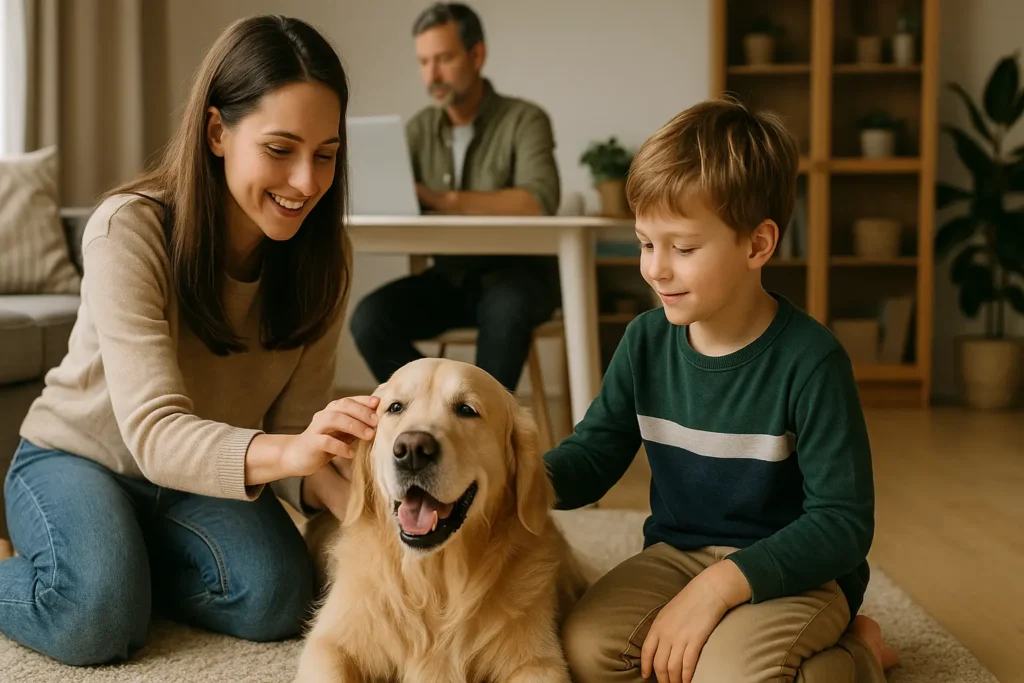How to Manage Pet Behavior Without Yelling or Punishment 🐾🧘
Yelling, scolding, or punishing a pet might seem like the only option when your dog won’t stop barking or your cat scratches the furniture—but those reactions don’t solve the problem.
In fact, they often make it worse.
Why? Because fear and confusion don’t teach. They only break trust.
The truth is: positive pet behavior training is not just more humane—it’s more effective, long-lasting, and enriching for both you and your animal companion.
This guide will show you how to manage unwanted behavior using patience, science, and trust-building techniques that actually work.

Why Punishment Fails (and Hurts) ❌
Let’s start by understanding why punishment often backfires:
1. It Damages Trust
Pets don’t understand “you did something wrong.” They understand: “you’re angry, and I don’t know why.”
Result: fear, anxiety, and avoidance.
2. It Teaches Nothing
Punishment doesn’t teach a replacement behavior. It only suppresses the current one (temporarily).
3. It Triggers Defensive Reactions
Pets under stress may freeze, flee—or fight. That includes growling, biting, or urinating from fear.
4. It Makes You Less Predictable
Yelling or harsh tone erodes your role as a calm, safe leader.
📉 WordPress Block Tip: Add a chart showing behavior outcomes from punishment vs. positive reinforcement over time.
Positive Training: What It Really Means 🌱
Positive reinforcement means rewarding the behaviors you want, not punishing the ones you don’t.
It’s based on behavioral science, and it works for all animals—including yours.
Core Principles:
- Catch your pet doing the right thing
- Reward immediately with food, praise, toys, or affection
- Ignore or redirect unwanted behavior
- Set the environment up for success (not failure)
- Be consistent
💬 Replace “No!” with “Let’s try something better.”
Dog Behavior Challenges & Positive Solutions 🐕
Let’s look at some common issues with dogs—and how to manage them using positive techniques.
🐶 Excessive Barking
Why it happens:
- Boredom
- Alerting
- Seeking attention
- Anxiety
What to do:
✅ Give structured play and exercise
✅ Train “quiet” with a reward
✅ Redirect barking to a toy or puzzle
✅ Avoid yelling—it sounds like barking back!
🐶 Jumping on People
Why it happens:
- Excitement
- Learned attention-seeking
- Lack of alternative behavior
What to do:
✅ Ignore jumping—no eye contact or touch
✅ Reinforce “sit” with treats every time
✅ Reward calm greetings consistently
✅ Ask guests to help by turning away from jumps
🐶 Pulling on Leash
Why it happens:
- Excitement
- Lack of impulse control
- Untrained walking behavior
What to do:
✅ Use a front-clip harness for safety
✅ Stop walking when they pull
✅ Reward when leash is loose
✅ Change direction frequently
🦴 Add a “Loose Leash Training Steps” infographic block
Cat Behavior Challenges & Positive Solutions 🐱
Cats are trainable too—with patience and creativity.
🐱 Scratching Furniture
Why it happens:
- Territory marking
- Nail maintenance
- Stress relief
- Lack of approved options
What to do:
✅ Offer multiple scratching posts with different textures
✅ Place posts near furniture
✅ Use catnip or treats on posts
✅ Reward use with praise or snacks
✅ Cover forbidden zones with double-sided tape
🐱 Litter Box Avoidance
Why it happens:
- Dirty box
- Box location
- Stress or health issues
- Scent or litter type
What to do:
✅ Scoop daily
✅ Provide 1 box per cat + 1 extra
✅ Use low-dust, unscented litter
✅ Keep in quiet, accessible spot
✅ Reward use with gentle praise
🐱 Biting During Petting
Why it happens:
- Overstimulation
- Poor body language reading
- Misdirected energy
What to do:
✅ Watch for tail flicking, ears back, pupil dilation
✅ Stop petting before the bite
✅ Use toys to redirect energy
✅ Build tolerance with slow touch and treats
🐾 Block Idea: “Signs Your Cat Is Overstimulated” chart
Positive Tools for Training Success 🛠️
You don’t need punishment—you need tools that teach.
Must-Have Tools:
- Treat pouch
- Clicker (for clicker training)
- Soft training treats
- Long leash or training lead
- Target stick (especially for cats)
- Puzzle toys and slow feeders
- Calming music or white noise machine
🧠 Training is most effective in short, consistent sessions—5–10 minutes at a time.
📦 Add a “Positive Training Starter Kit” block with recommended items
Redirect Instead of Scolding 🔁
When your pet does something unwanted, think:
What DO I want them to do instead?
Then train that.
Examples:
- Chewing shoe? → Offer a toy, then reward.
- Jumping on counter? → Train “off” and reward when all four paws hit the ground.
- Barking at the window? → Close curtains, then reward quiet behavior.
🗣️ Replace reaction with redirection.
Creating a Calm Environment 🕊️
Behavior is shaped by surroundings. Set your pet up for calmness, not chaos.
Tips:
- Keep consistent feeding and walk schedules
- Limit overstimulation (noise, people, new smells)
- Provide retreat spaces for alone time
- Use enrichment daily (puzzles, chew toys, games)
- Avoid confrontation—use calm energy
🌿 Block Suggestion: “DIY Calming Pet Corner Setup”
Managing Your Own Emotions 😤➡️🧘
Yelling often comes from frustration, not intention. Managing your own energy is key.
When you’re triggered:
- Pause.
- Breathe deeply.
- Step away if needed.
- Re-engage when calm.
Your pet reads your energy. Stay calm, and they’ll learn from your stability.
💭 Try journaling or tracking your own reactions during training for awareness.
When to Get Professional Help 📞
Positive doesn’t mean passive. If behavior problems persist or worsen, get support.
Look for:
- Certified dog trainers (CPDT-KA, KPA-CTP)
- Fear-free certified professionals
- Veterinary behaviorists
- Cat behavior consultants (IAABC, CATT)
🔍 Block Suggestion: “How to Choose a Positive Trainer” with checklist
Final Thoughts: Lead with Patience, Not Punishment 💕
Training isn’t about control—it’s about relationship. And when that relationship is rooted in respect, trust, and compassion, your pet becomes more than obedient—they become connected.
Ditch the yelling. Forget the fear. Teach with heart, and you’ll discover a version of your pet (and yourself) you never imagined.
Because when we train with love, we raise not just “well-behaved” pets—but emotionally balanced, deeply bonded family members.




Post Comment